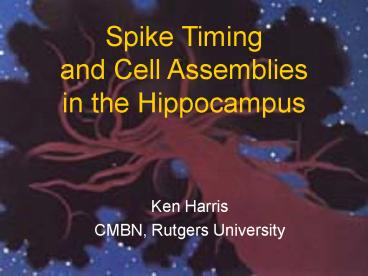Ken Harris - PowerPoint PPT Presentation
1 / 41
Title: Ken Harris
1
Spike Timing and Cell Assemblies in the
Hippocampus
- Ken Harris
- CMBN, Rutgers University
2
Two Views of the Cortex
3
Two Views of the Cortex
Bottom-Up
4
Two Views of the Cortex
Top-Down
Bottom-Up
5
The Cell Assembly
- Spatially distributed
- Fire Synchronously
- Can be activated by internal (top-down) as well
as external (bottom-up) factors
Hebb (1949)
6
Talk Outline
- Single cell level
- How do the exact spike times of a neuron relate
to the information it conveys? - What mechanisms could determine spike times?
- Population level
- How is spike timing coordinated across neurons?
- Can we find evidence for assembly organization?
- At what timescale are assemblies synchronized?
7
The Hippocampus
- Top of pyramid
- Memory
- Spike timing
8
Place Cells
Non-Spatial Correlates
Hippocampal pyramidal cells firing rate
correlates principally, but not exclusively, with
spatial location.
OKeefe and Dostrovsky, Brain Res, 1971 Harris et
al, Neuron, 2001
Wood et al, Nature, 1999
9
Theta Rhythm
theta
LIA
Appetitive behaviors REM
Consummatory behaviors SWS
10
Hippocampal Neurons Are Theta Modulated
11
Phase Precession Effect
Timing of spikes within the theta cycle
correlates with spatial position of rat
theta
Spatial position (distance - cm)
time
OKeefe Recce Hippocampus 1993
Harris et al, Nature 2002
12
Question
- Does phase precession only occur during spatial
behaviors, or is it a manifestation of a more
general principle? - We examined the relationship between phase and
spike train dynamics in spatial and non-spatial
behaviors. - If relationship is the same for all behaviors,
phase precession is not explicitly spatial.
13
Spatial and Non-spatial Behaviors
14
Phase Precession During Wheel Running
x
y
Harris et al., Nature 2002
15
Phase-rate Relationship
Harris et al., Nature 2002
16
Unidirectional Phase Advance
Phase-rate relation means phase should advance,
then retreat as rate rises and falls. But
phase retreat is not seen.
Harris et al., Nature 2002
17
Unidirectional Advance
Define a spike to be at the onset or offset of
activity directly from spike train.
Harris et al., Nature 2002
18
Spike Train Acceleration
Harris et al., Nature 2002
19
Precession at High Rates
Harris et al., Nature 2002
20
Interference Model
Theta
Somatic Inhibition
Dendritic Excitation
Weak Excitation Positive Phase
Harris et al, Nature, 2002
21
Interference Model
Somatic Inhibition
Dendritic Excitation
Strong Excitation Negative Phase
Harris et al, Nature, 2002
22
Adaptation and Unidirectional Precession
Phase reflects excitation strength, not firing
rate.
Harris et al., Nature 2002
23
Summary of Single-cell Data
- The relation of mean phase to spike dynamics is
similar in spatial and non-spatial behaviors. - This suggests phase precession is just one
manifestation of a more general processing
strategy. - What is it?
24
Hypothesis
- The phase precession effect is the reflection, at
a single cell level, of an organization of
neurons into cell assemblies.
25
Signatures of the Cell Assembly
- Spatially separated groups of cells that fire
synchronously - Synchrony exceeds that predicted from common
modulation by sensory input - Cells show preferences in the partners they join
in assembly activity
26
Timing Variability and Correlation
27
Synchrony in Spatially Distributed Populations
28
Predicting Spike Times
29
Cross-validation Method
- Likelihood is bits needed to transmit spike
train - Likelihood ratio estimates mutual information
30
Peer Prediction Method
Harris et al., Nature in press
31
Peer Prediction Method
Harris et al., Nature in press
32
Peer Prediction Method
Harris et al., Nature in press
33
Peer Prediction Method
Harris et al., Nature in press
34
Prediction From Phase
35
What Timescale?
- What is the temporal resolution with which cells
are bound into assemblies? - We can determine this by varying the peer
prediction timescale.
36
What Timescale?
37
Significance of 25ms
- Period of g oscillation
- Membrane time constant of pyramidal cells
- Time window for plasticity
Assembly activity at 25ms timescale is optimal
for transmission and storage of information
38
Hypothesis
- The firing of a hippocampal cell assembly
underlies the storage or recall of a discrete
memory item - Memory content has a spatial component
- Hippocampal firing rates will correlate with
space - This is why you have place fields
39
Summary
- Hippocampal units are organized into cell
assemblies, that fire synchronously with 25ms
resolution. - This pattern is optimal for information
transmission and storage, given the biophysical
constraints of neuronal circuits.
40
Whats Next?
Top-down
Bottom-up
41
Acknowledgements
- Gyorgy Buzsaki
- Hajime Hirase, Joszef Csicsvari, George Dragoi,
Darrell Henze, Xavier Leinekugel, Andras Czurko.































